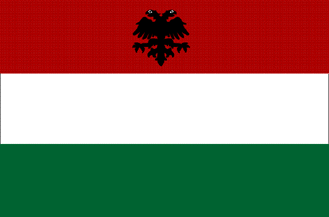LE BANDIERE
ALBANESI
Dal XIX secolo ad oggi
Dal
XIX secolo all'Indipendenza (1825 ca.-1912/1913), 6 bandiere
Dal
I Regno alla fine della Seconda Guerra Mondiale (1914-1918), 8 bandiere
Dal Governo di Reggenza alla I e II Repubblica,
fino al II Regno (1918-1939), 16 bandiere
Dal III Regno (Unione Personale
con l'Italia) al Governo Democratico (1939-1946), 11 bandiere
III Repubblica (1946-1991), 2 bandiere
III Repubblica: Marina Militare,
Guardia Costiera, Marina Mercantile (1946-1991), 11 bandiere
IV Repubblica (dal 1991), 2 bandiere
e 3 simboli di Stato
IV Repubblica: Marina Militare,
Guardia Costiera, Marina Mercantile (dal 1991), 4 bandiere
Kosova (dal 1974), 4 bandiere
Forza Multinazionale di Protezione,
1 bandiera
Bandiere di governi ribelli ed occupanti
stranieri (1914-1921), 11 bandiere
Bandiere di governi ribelli di etnia greca
in seguito retti dall’occupazione straniera di Atene
The Treaty of London (1913), which ended the Balkanic conflict, assigned
most of Epirus to Greece, but the northern districts remained within Albania,
with the opposition of the Greek population of the area. On 7 March 1914 the
prince Wied arrived in Albania and the Greeks of the Southern districts of
Albania rebelled against their inclusion in the principality, and formed a
provisional government of hepeiros (Epirus). The rebels used the Greek flag
with the double-headed eagle, to symbolize the belonging to Greece of this
part of Albania. The Greek government did not condone these actions, but secretly
supported the rebels. When the first World War broke up, the Greek troops
invaded and occupied Epirus (end of 1914). In the south, the provisional government
was dissolved and replaced by a military government. In Flagfax [flx]
is erroneously reported the flag of the occupation regime, taken from a postal
stamp, including the monetary unit (suppressed, naturally, in the next image,
where the wording says "Greek Epirus"). It is worth being noted that the flag
with the royal flag in the canton was not in use in the Kingdom of Greece
in 1914-16, having been adopted only later, in 1935. In the North, the rebel
government took the name of Government of Northern Epirus. The northern zone
of Epirus was handed over to the Italians in 1915 (the last Greek troops remained
in the area until 1916), which continued the occupation regime. After a few
months, the Italians transfered this area to their French allies. The Greeks
kept Southern Epirus. Two flags are supposed for this area: one from 1915-16
with wording that reads "Authonomous Epirus" and another from 1916, whose
writings read "Greek Authonomous Northern [Epirus]".
(for bibliography see: http://www.crwflags.com/fotw/flags/al-nepir.html)
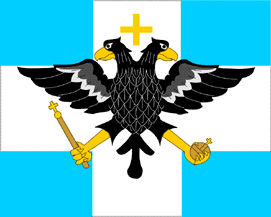
|
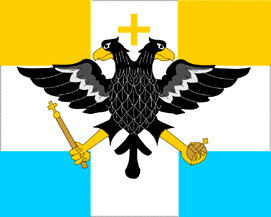
|

|
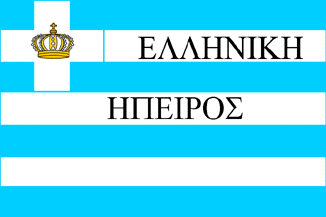
|
|
|
|

|
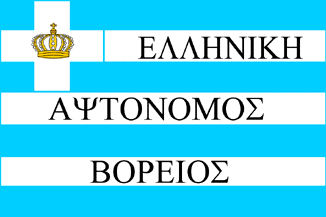
|
|
|
|
7 marzo 1914-1916: regime di occupazione greca nel meridione
dell'Albania,
territori in seguito liberati dagli Albanesi
Bandiere di occupanti stranieri
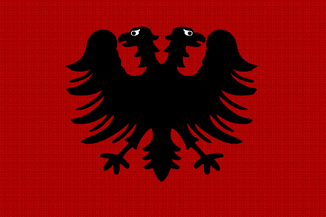
3 giugno-settembre 1917: Protettorato italiano su alcune zone
meridionali e a Vlorë
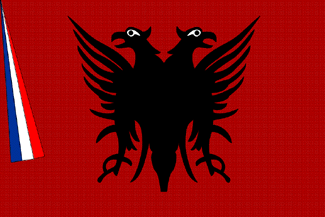
Giugno-settembre 1917: Repubblica di Korçë, zone di
Korçë ed Ersekë, controllate dai Francesi
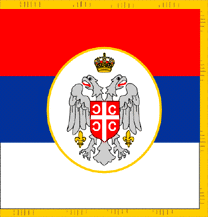
Autunno 1917: Regime di occupazione serba nel nord dell'Albania,
territori liberati poco dopo dagli Albanesi
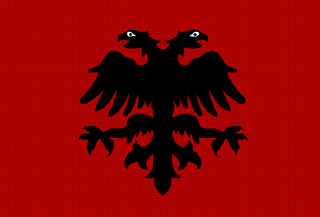
|
|
Ringrazio:
Giuseppe Bottasini, Jorge Candeias, James Dignan, Jan Oskar Engene, Mario
Fabretto, Zvi Har'El, Zeljko Heimer, Karl-Heinz Hesmer (Flaggen und Wappen
der Welt, scritto nel 1992), Antonio Martins, Muhamet Mesic, Harald Mueller,
Stuart Notholt, Jaume Ollé, Ivan Sache, Ivan Sarajcic, Mark Sensen, Anton
Sherwood, Roy Stilling, Bruce Ward, senza i cui ricerche, studi e disegni la
creazione delle pagine araldiche non sarebbe stata possibile.
BREVE
STORIA DELL'ALBANIA
Date, nomi, fatti
